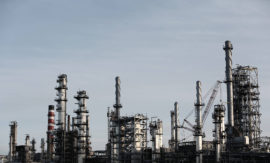Intended learning outcomes: Produce characteristics of the process industry. Disclose processor-oriented master and order data management. Explain in detail processor-oriented resource management. Describe special features of long-term planning.
The MRP II concept, which has been supported by ERP software for nearly 40 years, originated in in the fields of mechanical and apparatus engineering and in the automobile and aircraft industries. With MRP II and ERP software, a de facto standard emerged, consisting of common terminology, use of similar representations of the logistics objects, and principally similar planning & control methods. However, for repetitive manufacturing as well as for one-of-a-kind production, the MRP II concept has already required extensions in terminology, logistics objects, and methods. The same is taking place for process industries.
Process industries or basic producer industries are manufacturers that produce products by process manufacturing.
Process manufacturing is production that adds value by mixing, separating, forming, and/or chemical reactions. Process manufacturing may be done in either batch production, that is, production in batches, or in continuous production (cf. [APIC16]) .
Process industries comprises manufacturers of chemical products, paper, food, mineral oil, rubber, steel, and so on. In these industries, it became increasingly clear that the terminology, logistics objects, and fundamental methods of the MRP II concept could not always be applied without adaptation. Many aspects of process manufacturing are simply not comparable to the production of aircraft, cars, or machines ([Hofm92]). It is interesting, however, that no uniform standard had been accepted within the process industry ([Kask95]) and that efforts toward standardization have been made only in the past 10 to 20 years. Clearly, there is a need for more scientific research in this area.
A processor in the process industries is the processing unit, or production infrastructure, that is, the production equipment (machines, appliances, devices) and the capacities.
The processor-oriented concept aims toward mastering pronounced high-volume line or continuous production and specialized, expensive production equipment (or processors) with a focus on maximizing processor capacity utilization.
Process manufacturers make significant investments in specialized, often single-purpose production equipment. This makes utilization of capacity the key criteria for planning & control purposes, capacity taking precedence over materials, components, and the fastest possible flow of goods.
Figure 8.0.0.1 shows some of the characteristic features for planning & control in supply chains, taken from Section 4.4. The typical values of the feature of greatest importance for this concept are highlighted in black. The further to the right that these values appear in the table, the better candidate the industry is for the use of the processor-oriented concept.
Fig. 8.0.0.1 Degree of suitability for the processor-oriented concept. (The horizontal distribution of the values in the morphological scheme indicates their relation to the increasing degree according to the given criterion).
After identifying the characteristics of the process industry, the next step is to derive appropriate processor-oriented techniques for planning & control.
Course 8: Sections and their intended learning outcomes

Course 8 – The Concept for the Process Industry
Intended learning outcomes: Produce characteristics of the process industry. Disclose processor-oriented master and order data management. Explain in detail processor-oriented resource management. Describe special features of long-term planning.

8.2 Processor-Oriented Master and Order Data Management
Intended learning outcomes: Produce an overview on processes, technology, and resources. Present the process train: a processor-oriented production structure. Disclose lot control in inventory management.

8.3 Processor-Oriented Resource Management
Intended learning outcomes: Explain campaign planning. Differentiate between processor-dominated Scheduling and material-dominated scheduling. Describe a nonlinear usage quantity and a product structure with loops.

8.4 Special Features of Long-Term Planning
Intended learning outcomes: Disclose the determination of the degree of detail of the master production schedule. Describe pipeline planning across several independent locations.

8.5 Summary
.

8.6 Keywords
.

8.7 Scenarios and Exercises
Intended learning outcomes: Differentiate between batch production and continuous production. Calculate an example of manufacture of by-products. Elaborate an example of production planning in process industries.

8.8 References
.
![Case [Course 8]](https://opess.ethz.ch/wp-content/uploads/2017/02/08-270x163.jpg)
Case [Course 8]
.

8.1 Characteristics of the Process Industry
Intended learning outcomes: Explain divergent product structures and by-products. Describe high-volume line production, flow resources and inflexible facilities. Produce an overview on large batches, lot traceability, and loops in the order structure.
